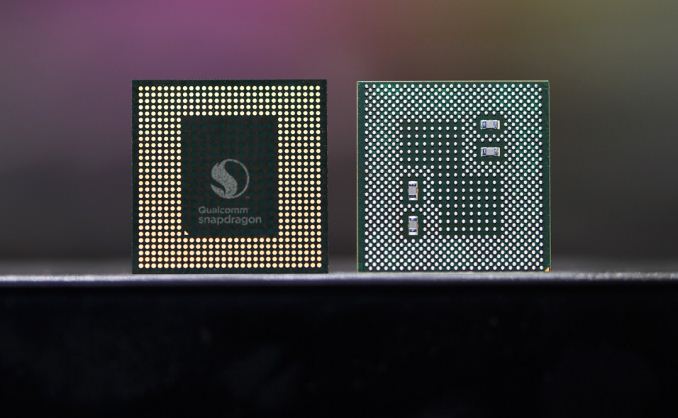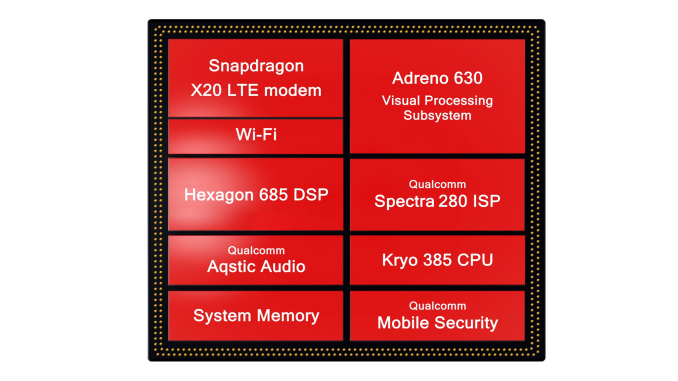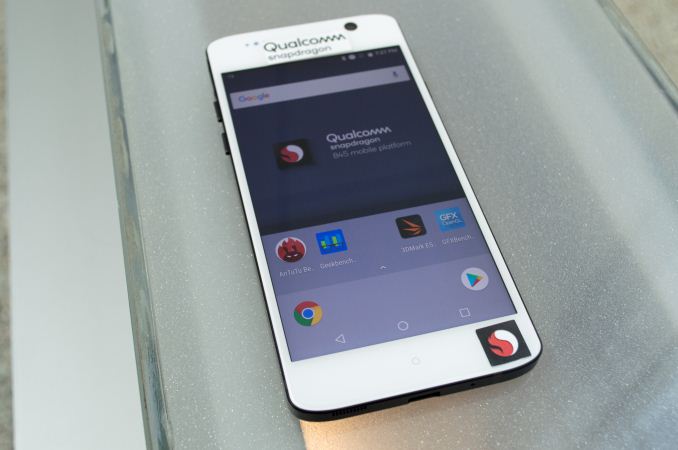The Snapdragon 845 Performance Preview: Setting the Stage for Flagship Android 2018
by Ryan Smith & Andrei Frumusanu on February 12, 2018 12:30 AM EST- Posted in
- Mobile
- Snapdragon
- Qualcomm
- Smartphones
- SoCs
- Snapdragon 845

In what has become an annual tradition for Qualcomm, the company has once again opened the doors of their San Diego headquarters to the press to take a preview look at the next generation of their flagship mobile platform. These events have been going on for several years now, and have become an integral part of how Qualcomm approaches the public with their wares; preview events not only let them set expectations, but to get the word out to technically-minded audiences in a vendor-neutral manner. Rather than being one part in the next flagship smartphone, preview day means that everything can be about Qualcomm and the platforms that they have created.
Late last year Qualcomm announced the Snapdragon 845 platform, the successor to 2017’s Snapdragon 835. Implementing a number of important architectural improvements over its predecessor, the Snapdragon 845 gets to follow-up on what ended up being a rather well-received platform in the Snapdragon 835, and to see if Qualcomm can maintain their momentum. Qualcomm used their December event to release a good bit of info on the 845 in advance, so we’ve already had a chance to see what Qualcomm is planning architecturally. And now with the preview event we finally get to see how all of this comes together with a look at the platform as a whole.
Whenever discussing the state of affairs of Qualcomm’s flagship SoCs, I always struggle not to tie it to the Snapdragon 810 in some fashion. Which not to beat Qualcomm over the head for past mistakes – in that case a poorly thought out response to Apple – but rather because it serves as a such a great point of reference for discussing the company’s SoC development as a whole. 810 was arguably the company’s low point, so everything since then has been part of a rather remarkable upward trajectory for the flagship Snapdragon. Even though Qualcomm has been leading the pack in high performance SoCs for several years now, last year’s Snapdragon 835 in particular really felt like Qualcomm was in that position for all-around technical capabilities and not merely because of size, momentum, and the realities of LTE licensing.
All of this means that there’s a lot riding on the Snapdragon 845, just in a different and less obvious way than before. Qualcomm has redeemed themselves from the 810 and it’s not a question of whether they can put together a great SoC, but instead it’s a question of how they will follow up upon a great SoC like the 835.
| Qualcomm Snapdragon 845 vs 835 | |||
| SoC | Snapdragon 845 | Snapdragon 835 | |
| CPU | 4x Kryo 385 Gold (A75 derivative) @ 2.8GHz 4x256KB L2 4x Kryo 385 Silver (A55 derivative) @ 1.77GHz 4x128KB L2 2MB L3 in DSU |
4x Kryo 280 Gold (A73 derivative) @ 2.45GHz 2MB L2 4x Kryo 280 Silver (A53 derivative) @ 1.90GHz 1MB L2 |
|
| GPU | Adreno 630 | Adreno 540 @ 670/710MHz | |
| Memory | 4x 16-bit CH @ 1866MHz LPDDR4x 29.9GB/s 3MB system cache |
4x 16-bit CH @ 1866MHz LPDDR4x 29.9GB/s |
|
| ISP/Camera | Dual 14-bit Spectra 280 ISP 1x 32MP or 2x 16MP |
Dual 14-bit Spectra 180 ISP 1x 32MP or 2x 16MP |
|
| Encode/ Decode |
2160p60 10-bit H.265 720p480 |
2160p30 (2160p60 decode), 1080p120 H.264 & H.265 |
|
| Integrated Modem | Snapdragon X20 LTE (Category 18/13) DL = 1200Mbps 5x20MHz CA, 256-QAM UL = 150Mbps 2x20MHz CA, 64-QAM |
Snapdragon X16 LTE (Category 16/13) DL = 1000Mbps 3x20MHz CA, 256-QAM UL = 150Mbps 2x20MHz CA, 64-QAM |
|
| Mfc. Process | 10nm LPP | 10nm LPE | |
The answer to that comes in the form of the Snapdragon 845, an interesting SoC that is a “tock” design if there ever was one. Qualcomm doesn’t get the advantage of an entirely new manufacturing node – the 845 is being made on Samsung’s second-generation 10LPP process, a refined version of 10LPE used for the 835 – so Qualcomm’s improvements are rooted almost entirely in architecture rather than a mix of architecture and manufacturing. Which is to say that it’s a bit of an uphill challenge for the company, but the flip side of that argument is that it’s going to be a chance for Qualcomm’s architectural engineers to take attention front and center.
What the Snapdragon 845 entails then, as we originally learned late last year, is a series of upgrades and overhauls across all the various subsystems of the SoC. Arguably the biggest news here is that Qualcomm’s latest-generation Kyro 385-series CPU cores are derived from ARM’s Cortex-A75 and A55 designs, and that the resulting SoC is the first to employ ARM's DynamiQ CPU cluster organization. DynamIQ enables the various different CPU cores within an SoC to be hosted within the same cluster and cache hierarchy, as opposed to having separate discrete clusters with no shared cache between them, allowing for finer-grained and more efficient approaches to when and how various clusters are powered up. Meanwhile on the GPU side, the notoriously tight-lipped GPU group over at Qualcomm has confirmed that the Snapdragon 845 implements the first Adreno 600 series GPU, which in turn is the first new GPU architecture from Qualcomm in a couple of years and promises some significant performance improvements.
Outside of the core processor architecture, the changes in the rest of the SoC are perhaps not quite as dramatic, but still important to the platform as a whole. This includes, of course, Qualcomm’s latest and greatest LTE modem, the Snapdragon X20, upgrading Qualcomm’s LTE capabilities category 18. Both the camera ISP and Hexagon DSP have also been upgraded as well with the introduction of the Spectra 280 and Hexagon 685, which Qualcomm will be leveraging for camera image quality improvements and their stake in the modern mobile AI race respectively. Finally, the SoC also includes the latest version of the company’s Aqstic audio codec, which although audio has not traditionally been heavily promoted by the company, will be an increasingly important part of differentiating itself from other high-performance mobile SoCs.
Getting down to the heart of matters then, this year’s flagship Snapdragon platform preview is a lot like last year’s. We’re once again taking a look at a Qualcomm Reference Design (QRD), which is a fully functional smartphones in a slightly oversized, utilitarian chassis used for hardware testing and software development. The Snapdragon 835 QRD was a 5.5-inch equivalent phone, and for the 845 QRD Qualcomm has stuck with much the same. The device itself is unremarkable, featuring a 1440p LCD and 6GB of LPDDR4X memory, but it’s otherwise typical of the class of Snapdragon 845 devices we expect to see starting a bit later this year.
Similarly, while this is still a preview, final device performance shouldn’t be too much different from what we see with Qualcomm’s QRD. Vendors do make customizations to both hardware and software, so how a device’s cooling system is built or how aggressive the power management is configured will have an impact on final performance. But as far as stock performance goes, the QRD is about as neural as it gets, if not a slightly idealized case for the platform as it allows Qualcomm to optimally configure the phone themselves.












140 Comments
View All Comments
gamertaboo - Monday, February 12, 2018 - link
Well, you sure see wildly different scores if you compare them using Geekbench. 4260 vs 1998 on single core, and 10,221 vs 6765 on multi-core I believe. Apple's chips are always faster, always. It's literally the one thing Apple at the very least, always does well.Gk12kung - Tuesday, February 13, 2018 - link
Dude your extremely mistaken , the processors in the x and 8 are differently binned . Since apples GPU is inhouse this year they couldn't get enough high quality GPU in time so the x uses higher binned gpu than 8 so the higher performance and the x uses faster ram than 8 which is also a factor in GPU scores . I've used a 8 and x there is rarely any throttling the d220AP is the lower GPU revision used in 8 and d221ap is the x version with higher bin GPUBronzeProdigy - Tuesday, February 13, 2018 - link
The GFX bench is also wrong. The A11's GPU is behind. If you look at the sections for the X you'll see N/A. Look at the SD835/5T scores and you'll see they match up but the score on that test either doesn't exist or doesn't match the X's score. This is because they failed to note that the GFXBench has different versions (e.g. 3.1, 2.7, 3.0) so they wrote the wrong scores thinking that the scores on the X were something they're not.https://uploads.disquscdn.com/images/9c0ebbebc7b3c...
peevee - Tuesday, February 13, 2018 - link
Except in real life users do not run SPEC for long time. They load and start apps, or process photos. It all takes less than a second.rocky12345 - Tuesday, February 13, 2018 - link
Yea because no one ever plays any games on theirs mobile devices which can go from 5 minutes to 5 hours of use and will heat up any device no matter who makes them. So if you have devices from a mobile maker that is known to heat up & then throttle from that heat then yep it won't be as fast as in the benches. I don't care if Apples makes them or Samsung it happens to every device but it happens worse on some than it does to others.Stochastic - Monday, February 12, 2018 - link
This looks like a nice, albeit not earth shattering overhaul to the 835.Any chance we'll see a Google SoC in the Pixel 3 this year? Or is it more realistic to expect that in the Pixel 4/5? It's a bit boring seeing Snapdragon SoCs in practically all Android flagships.
Also, what's up with Chrome's lackluster Javascript performance? You mention that the Nitro engine Apple uses is much better optimized. You would think with all the competition in the browser space these days and Google's vested interest in the future of the web that they would push Javascript performance further.
Jon Tseng - Monday, February 12, 2018 - link
Not going to happen for a bunch of reasons, not least bc Google doesn't have baseband IP.Dr. Swag - Monday, February 12, 2018 - link
I don't think we'll see Google SoCs unless pixel really gains market share. Not worth it to design and fabricate soc if you only sell a few millions phones.Stochastic - Monday, February 12, 2018 - link
Yes, but this would help them gain marketshare. They could perhaps even license the SoC to other OEMs in order to advance the Android hardware ecosystem as a whole. See this: https://www.androidauthority.com/google-dabbling-s...techconc - Wednesday, February 14, 2018 - link
Regarding Javascript performance, this article is placing far too much emphasis on the Javascript engine. Yes, Apple's Nitro engine is ahead of Google's V8 engine. However, the majority of the speed difference comes down to the fact that Javascript is inherently single threaded. (Yes, I know work is being do to attempt to address this, but it's not there yet). That, coupled with the fact that Apple's single core performance is WAY ahead of everyone else on ARM is why you see such a big difference in performance.